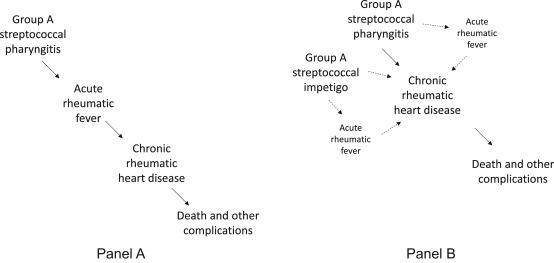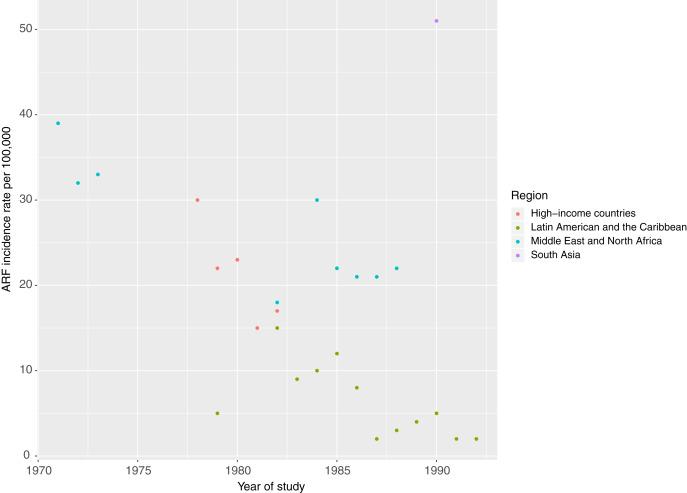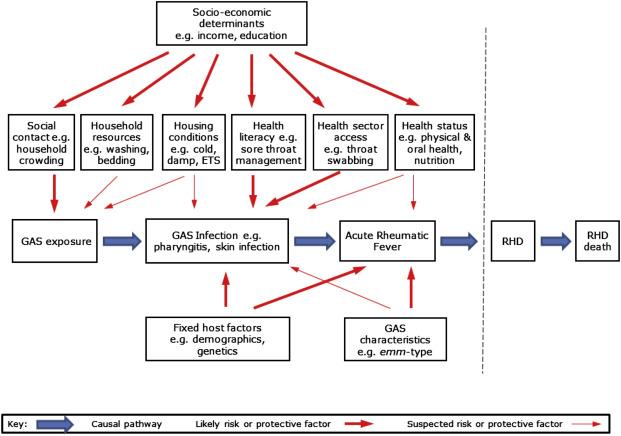Physical Address
304 North Cardinal St.
Dorchester Center, MA 02124
Acute rheumatic fever (ARF) is an immune-mediated, nonsuppurative consequence of group A β-hemolytic streptococcus (GAS) infection. Although episodes of ARF can result in significant disability, the major impact of ARF at the population level is that it causes long-term, irreversible damage to heart valves—termed rheumatic heart disease (RHD)—often as a result of recurrences. For this reason, we discuss the epidemiology of two conditions together emphasizing they continue to be a major public health problem in many parts of the world, resulting in substantial disability, premature mortality, and economic losses.
This chapter summarizes four basic types of information. We first review the primary literature on the epidemiology of ARF and RHD, and then we summarize what is known about major risk factors for the conditions. We go on to discuss “global” disease burden estimates, that is, efforts to synthesize and aggregate the primary descriptive epidemiology literature to estimate levels and trends in fatal and nonfatal RHD. We conclude by highlighting what is known about the economic consequences of RHD.
The epidemiological model of ARF/RHD predominant in the literature suggests a clear stepwise relationship between GAS, ARF, and RHD. Although this relationship remains important, the situation is likely to be more complicated, especially in the settings where RHD is endemic today ( Fig. 1.1 ) For example, in most low- and middle-income countries (LMICs), RHD is reported much more frequently than ARF, with most patients presenting for the first time with complications of RHD in late adolescence or early adulthood.

A variety of approaches (study types) have been used in the literature to measure ARF and RHD incidence, prevalence, and mortality. Each has limitations and advantages, so getting a complete picture of the burden of ARF/RHD in a country will often require triangulating multiple sources of data derived from different types of studies ( Table 1.1 ).
| Study Type | Limitations | Advantages |
|---|---|---|
| Clinical registries | Heavily dependent on referral pathways: Healthcare infrastructure in the area and willingness of the potential sources of referral Underreporting: Mild cases, missed diagnosis, marginalized sections of the population may be missed altogether Overreporting: Sampling from outside the study area due to referral to specialist centers Denominator: Dependent on census data, errors may result from under or over estimation of the migrant population |
Wide coverage Relatively easy to organize |
| Community-based surveys | Logistics of selecting a representative population of a region can be challenging Regions with low prevalence require very large sample size | Better suited for high-prevalence regions Clearly defined denominator |
| School surveys | Focus entirely on the 5–15-year-old group Limited value in areas with poor school enrollment rates Affected children may not attend schools (absenteeism) School surveys may yield a much lower prevalence in regions where affected RHD patients are older |
Clearly defined denominator Allows systematic and well-organized survey Better suited for RHD than ARF |
| Hospital statistics | Outpatient clinic records and inpatient admissions: Only those who are relatively sick will be represented Procedure records: Likely to miss valve lesions that do not require a procedure |
Diagnosis is likely to be accurate although usually dependent on clinical coding |
| ARF/RHD mortality statistics | Underreporting in areas with poor health infrastructure Weak mortality statistics in some regions (e.g., Africa) Misclassification of underlying cause of deaths (e.g., coded as heart failure or stroke instead of RHD) |
Premature mortality is a key measure for estimating disease burden |
Few contemporary studies have been published on the epidemiology of ARF worldwide. The most up-to-date summaries of ARF incidence data come from two systematic reviews and a recent Lancet Seminar. Seckeler and Hoke also review studies conducted before 1970. In addition, some regions of the world—such as Africa—remain underrepresented in the literature. Among the published estimates, rates are reported to vary from 5 to 50 per 100,000 person-years. Rates as high as 194 per 100,000 have been reported among Indigenous populations in the Northern Territory of Australia, but it is not clear whether these figures represent truly “higher” rates than the rest of the world, or whether surveillance is simply better, leading to improved ascertainment. Where it has been measured, the incidence of ARF appears to be declining over time ( Fig. 1.2 ), though again, the regions of the world that are currently very poor and endemic for RHD are underrepresented in this literature.

A major inconsistency in the literature is a lack of a clear relationship between high incidence of ARF and high prevalence of RHD. For instance, one recent study of ARF epidemiology set in primary care clinics in Fiji (where RHD is known to be highly endemic) found only 25 cases per 100,000 population of definite ARF at ages 4–20 years. However, relative to the number of definite ARF cases, substantially more cases of polyarthralgia and monoarthritis were observed, raising the possibility that ARF is underdiagnosed in these settings. There are several possible explanations for the scarcity of ARF in these settings including (i) a distinct clinical phenotype in which progression to RHD tends to be subclinical, (ii) the relative availability of antiinflammatories and antibiotics that may mask florid ARF, (iii) low rates of presentation to healthcare to receive a diagnosis of ARF, which can reflect both lack of awareness among the general public as well as barriers to accessing primary healthcare services, and (iv) low recognition of ARF among healthcare workers—a problem made more challenging by the 2015 Jones criteria, which require the use of echocardiography to make a diagnosis of ARF in most cases.
One other challenge in interpreting the ARF literature is that many studies fail to differentiate between primary (first) attacks of ARF and recurrences, and some studies have only measured primary ARF. Estimates of the incidence of primary ARF are useful in understanding the proportion of the population affected and in tracking the success of primary prevention programs. Estimates of the incidence of recurrent ARF are useful in tracking the success of secondary prevention programs—that is, high recurrence rates suggest low levels of adherence to antimicrobial prophylaxis. Together, estimates of the incidence of both primary and recurrent ARF paint a picture of the true population exposure to GAS (which is responsible for both types of ARF) and other risk factors.
A systematic review of RHD prevalence studies conducted in 2016 for the Global Burden of Disease 2015 study found data on RHD prevalence from 59 countries. Most of these datasets were echocardiography-based prevalence studies conducted in LMIC settings; however, this review also included hospital administrative datasets (mostly from high- or upper-middle-income country settings) and auscultation-based prevalence studies. This review complements a 2014 systematic review by Rothenbühler and colleagues that identified 33 datasets from auscultation- or echocardiography-based RHD prevalence studies in LMICs.
School-based echocardiographic surveys of asymptomatic children have become the standard means of assessing the prevalence of RHD. The 2012 World Heart Federation criteria for RHD have helped enforce some standardization in reporting, but questions remain about the epidemiological significance and clinical implications of “latent” RHD (including “borderline” and “subclinical” definite RHD). Short-term follow-up studies suggest that the vast majority of subclinical RHD remains stable or regresses. Subclinical RHD is associated with worse long-term outcomes than similar individuals in the population who do not have subclinical RHD, though the risk of complications is nearly 10 times higher among individuals with clinically diagnosed RHD. Overall, longer-term follow-up studies are needed to understand the link between subclinical RHD in children and RHD-related disability and mortality in later life. Additionally, it remains a possibility that the current definitions of subclinical and borderline RHD are capturing some individuals who do not actually have RHD.
Similar to ARF, RHD is experiencing a decline in many LMICs paralleled by improvements in human development. For example, Negi and colleagues conducted a study using a stratified sample in Northern India using identical survey methods in 1992–93 and 2007–08. They found a fivefold reduction in RHD prevalence in school children between 5 and 15 years together with a sharp decline in recurrent ARF among RHD patients during this period. Sociodevelopmental indices in this region of India improved substantially between 1992 and 2008. Similarly, southern Indian states that have much better sociodevelopmental indices than their northern counterparts have also shown a markedly reduced prevalence of RHD in recent surveys. This was also demonstrated in a large study across 10 districts of India conducted by the Indian Council of Medical Research. The same pattern is also apparent in cross-country comparisons of RHD prevalence.
At the same time, “hot spots” of RHD have been documented in middle-income countries, such as Brazil, that have high rates of economic and health inequality across subnational units. These subnational hot spots could be masked by country-level estimates, which reflect the average of low- and high-risk populations. Within relatively small regions, there are consistently demonstrable gradients in RHD prevalence that point toward the influence of poverty and access to healthcare on the disease. Rural populations have consistently higher prevalence in comparison to their urban counterparts. This has been demonstrated in both clinical and echocardiographic surveys. Some of the highest RHD prevalence estimates ever reported have come from studies involving the poorest sections of the society. These studies also report aggressive disease patterns such as early onset mitral stenosis that have almost disappeared from low-prevalence regions.
At an ecological level, a strong correlation was found between increasing ARF/RHD rates and decline in access to primary care in central Asia after the breakup of the Soviet Union. Conversely, some LMICs with excellent primary care such as Cuba, Thailand, and Sri Lanka have levels of ARF and RHD that are comparable to high-income countries.
The Global Burden of Disease study also estimated the worldwide prevalence of heart failure because of RHD over 1990–2015. For 1990, the estimated prevalence of mild, moderate, and severe heart failure was 160,000, 130,000, and 350,000 cases, respectively. The corresponding prevalence for 2015 was 300,000, 240,000, and 660,000 cases. The increase in the number of prevalent cases of RHD-associated heart failure has primarily been due to population growth and aging, a trend that will probably continue over the coming decades. Heart failure carries a significant risk for death and other adverse health outcomes (discussed in detail in Chapter 16 ).
Relatively little is known about mortality from RHD in some world regions, particularly in African countries without vital registration systems (i.e., standardized approaches to recording and certifying deaths, including their cause). Even in countries with complete vital registration, accurate measurement of RHD-related mortality can be challenging for a number of reasons. Perhaps the most significant of these is that the WHO International Form of Medical Certificate of Cause of Death specifies that there can only be one “underlying” cause of death. Among individuals with RHD, it is likely that many deaths are being coded to sequelae such as atrial fibrillation, endocarditis, and stroke, or to nonspecific causes of death such as heart failure, rather than RHD. In the settings where RHD is endemic, clinical differentiation between the causes of heart failure or the underlying etiology of stroke is typically challenging, particularly if availability of echocardiography is limited. Consequently, if an individual with RHD dies after an ischemic stroke, there is no clear consensus on whether such a death should be assigned to RHD itself or to stroke (or to atrial fibrillation, for that matter), and it is likely that coding practices vary greatly by region. As the global population with RHD ages and becomes increasingly exposed to risk factors for atherosclerotic coronary and cerebrovascular disease, these sorts of confusions will probably become amplified and will require better coding guidelines to track RHD mortality accurately.
Despite the challenges in assigning deaths to RHD, there is a strong consensus that in endemic settings RHD is a significant contributor to risk of mortality. For example, in one study, at least 10% of patients with RHD who were admitted to the hospital (for any reason) die from their disease. However, few studies have examined rates of RHD-attributable mortality in the general population, not least because of the difficulties assigning the underlying cause of death outlined earlier. One alternative approach to this problem is to estimate how often patients with RHD die compared to individuals in the general population who have similar characteristics. (This approach is widely used in cancer epidemiology because, similar to RHD, patients with cancer often die of complications rather than cancer itself.) In Fiji, for example, excess mortality due to RHD was examined by combining multiple sources of routine data using probabilistic record linkage. The authors were able to provide the first population-based estimate of RHD-related mortality in an LMIC setting, 9.9 deaths per 100,000 population. In this study, almost half of RHD-attributable deaths occurred before age 40, and there were 1.6-fold more deaths than reported through the death certification process and twofold higher rates in some age groups than estimated in the Global Burden of Disease 2013 study. Although the generalizability of this study beyond the Pacific region is limited, it is clear that RHD can be a significant contributor to mortality in endemic countries beyond what is reflected in vital registration statistics.
One important subpopulation at excess risk of mortality from RHD are pregnant females. Hemodynamic changes during pregnancy are poorly tolerated in the presence of some lesions such as severe mitral and aortic stenosis and among individuals with pulmonary hypertension (see Chapter 9 ). In countries where there is low capacity to diagnose RHD during pregnancy and refer for specialist antenatal care and delivery, a significant proportion of pregnant women with severe RHD experience fetal loss, critical illness, or even death. The most striking example is a report from Senegal that estimated a case fatality ratio of 34% for pregnant patients with structural heart disease.
There are considerable gaps in knowledge about the etiology, pathogenesis, and risk factors for ARF/RHD that currently limit our ability to develop and implement effective interventions for this disease. Drawing on studies identified in prior literature reviews, we discuss the factors that have been associated with an increased or decreased risk of ARF and RHD. A variety of study designs have been used to address this issue, including case-control studies, cross-sectional studies, and cohort studies. Interpretation and generalization of study findings is difficult, because the majority of such studies have been small and frequently of poor quality. Still, broad conclusions are possible, and the wide range of potential risk factors can be organized according to a conceptual model ( Fig. 1.3 ). These factors are discussed in the following sections.

Become a Clinical Tree membership for Full access and enjoy Unlimited articles
If you are a member. Log in here